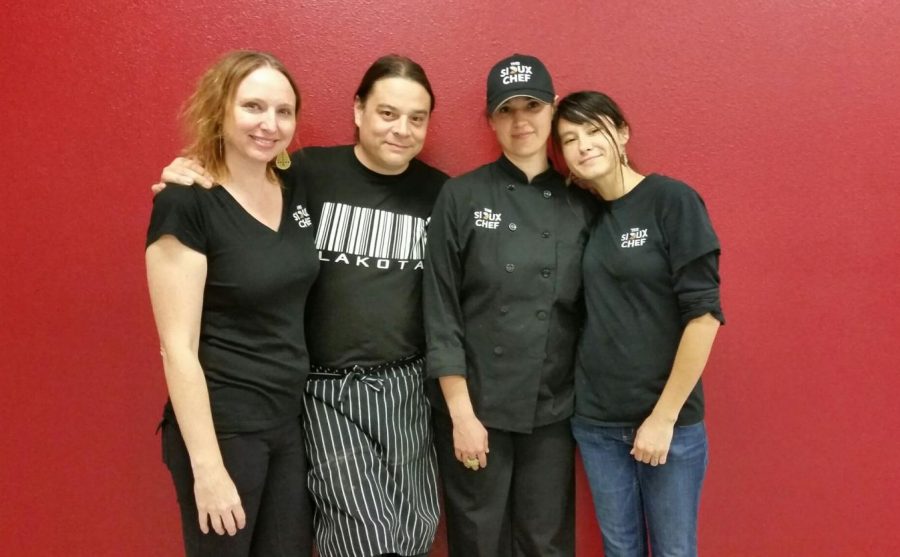The Sioux Chef Presents at Black Hills State University Center for American Indian Studies
RAPID CITY – The Sioux Chef, Oglala Lakota Sean Sherman sits front-and-center in the movement to revitalize indigenous foods. His culinary creations delighted 26 students and six faculty and staff members on Sept. 13 at the Black Hills State University Center for American Indian Studies.
His presentation focused on “pre-contact foods”. These are foods indigenous to the Americas before European contact. He also served a tea made of spruce, rosehips and wild mint, which he and staff foraged earlier in the day from Spearfish Canyon.
According to Rosie Sprague, assistant director of the American Indian Studies Center, Sherman spoke of his early beginnings working in the food industry. He started at the age of 13 in a Spearfish restaurant, and later started his first food truck, Tantanka. He also spoke to students and faculty about sustainable farming and showed examples of indigenous farming practices, which included floating gardens done by early peoples of Mexico, and waffle farming techniques of the Pueblo peoples.

Sioux Chef Partner and CPO Dana Thompson said the foods they serve in their Minneapolis-based catering business is gluten-free, dairy free and free of refined sugar. Their dishes consist primarily of wild edibles and the wild game of the region – Lakota, Nakota, Dakota and Chippewa foods.
The food becomes so low-glycemic and nutritious, Thompson said it really fits into every food trend.
“We don’t see this as a trend, it’s just the food of our grandparents, but it’s really healthy,” said Thompson, “Healthy for people with diabetes and people interested in preserving their hearts, and focusing on nutritious food.”
She and partner Sherman own a fully staffed catering business and food truck, Tatanka Truck, in Minneapolis. They recently launched a very successful Kickstarter to open their first restaurant.
Thompson said the impetus to research this movement was to bring back these foods knowing people’s culture and identities are tied to their ancestral roots – grandparents and great-grandparents. Talking to people from many continents, Sherman of the company, The Sioux Chef, found that most hadn’t worked that hard to put together their familial foods.
“Native Americans have had that piece taken away from them – when removed from their food sources. The fact that is was so systematically removed is really troubling to us,” Thomson said, “So we want to get that back – into tribal land and Native American communities, because spiritually it’s really important, from a cultural standpoint – but also the health aspect is huge for us.”
The team returned recently from a two-month trip in Europe where they worked in tandem with an indigenous chef from India. They also received a very favorable feature review in The New York Times food section.
“Coming from an indigenous oral tradition, they don’t really have recipes. Sean writes his own recipes just based on the ingredients that we can find,” Thompson said, adding that they both draw from their families for inspiration. His, from Pine Ridge, and Thompson’s four tribal lines on her mom’s side: Mdewakanton, Sisseton-Wahpeton, Hidatsa and Ojibwe.
One of the main edibles they use in their cooking is Labrador. This leadplant grows wild throughout northern Minnesota. This also makes a type of tea.
“When you make this tea for Native communities, they remember this as something they would drink all the time growing up,” said Thompson, “Gooseberries, buffalo berries, chokecherries – those are items that aren’t necessarily used as much in modern day but we find a lot of value in them.”
The two are knee-deep in planning their soon-to-come restaurant named, “The Sioux Chef, an Indigenous Kitchen.” They are currently scouting for space in the St. Paul or Minneapolis area. The plan for the 4,000-square foot plus space is to house 130 dining seats, an extension of their successful catering operation, and a small culinary training school.
“We want to be able to give cooking classes, have other chefs come in and interact with our chefs and learn so that they can take this knowledge back to their own communities,” Thompson said.
They have their own team, composed of five different Native tribes: Chef Vern Dafoe, Red Cliff Band of Lake Superior Chippewa; Brian Yazzie, Navajo flavors; Frank Haney, Oneida; Rachel Smith, Rosebud Sioux Tribe; father & son chefs, Mike Lee and Darius Willard, Northern Cheyenne Tribe, MT and of course, Oglala Lakota Chef, Sean Sherman. They want to employ as many chefs as they can.
“They are able to research the flavors of their own region and play with that on their own plates too,” said Thompson.
Among their inspiration they name Apache Chef, Nephi Craig, as well as Loretta Barrett Oden, a Pottawatomi chef.
“We call her the grandmother of this whole movement because she was doing it before Sean was doing it – at the Corn Dance Café (Santa Fe),” Thompson added, “She’s been such a great advocate and inspiration for us.”
Reaching as many people as possible is their goal, and they are known for their presentations to tribal communities and schools such as the one experienced last week at BHSU. Thompson said they might have some type of television presence in the future so they can focus on the tribal regions all around North America. She also mentioned development of a natural foods brand to focus on all the difference tribes.
“We just want to raise awareness to the diversity of flavors all throughout North America,” said Thompson, “We’re going to keep doing that as long as we can.”



